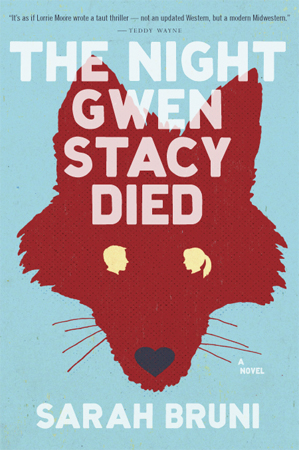
Sometimes pulp is a detective in a fedora brandishing a revolver; sometimes it’s a rocket ship and a ray gun. Sometimes it’s more complex than that; sometimes certain basic elements are reworked and run through varying sensibilities. One can see the influence of Mickey Spillane’s stark prose on James Ellroy and David Peace, even as each brings their own particular sensibility to the table. (Related: this New York Times Magazine roundtable discussion of pulp is essential reading.) The three books discussed today have elements familiar to the pulp reader, but the directions they take those in are gripping, meditative, and sometimes chilling.
I may well end up writing more about Sarah Bruni’s The Night Gwen Stacy Died in the not-so-distant future. It’s deceptively simple, and the plot, with numerous riffs on superheroes (specifically, the Spider-Man comics of the 1970s) hits a particular sweet spot for me. The short version: protagonist Sheila attends high school and works at a gas station to save money for a trip to Paris after graduation. A slightly older man — mid-twenties or so — periodically visits; as it transpires, he thinks of himself as Peter Parker, and he’s looking for a Gwen Stacy. The loosest possible outlines of a kidnapping and robbery ensue, and yet another pulp tradition makes its appearance.
As we’ll come to learn, for all that he’s deluding himself, Peter’s backstory is quite compelling — after his suicidal older brother leaves his life, Peter slowly finds himself having visions of danger. In other words, he has a superhero’s origin story — just not in a world where there are actual superheroes. It’s touches like this that make Bruni’s novel stand out; this isn’t simply a novel of broken dreams and the lies we tell ourselves. It’s about fiction, and identity, and the way destiny (or what we think of as destiny) affect us. Gwen Stacy, you might remember, didn’t meet the best of fates. Will Sheila? It’s a question that hangs over this taut, haunting novel.
Jeremias Gotthelf’s The Black Spider is a story nestled with in a story; the lord of a feudal estate oversteps his power, setting an impossible task and cruel punishments for his subjects if they fail at it. Impossible choices are made after a stranger comes offering a bargain that falls into the “too good to be true” category. At times, it reads like a metaphor for evil — one horrible decision begetting an abundance of terror. But there’s also a fair amount of body horror present in the novel as well — more than I would have expected from a novel written in the early 1800s.
I’ve been catching up on Nicola Griffith’s back catalog this year, and this week it came time for me to read her novel The Blue Place, the first of three novels she’s written featuring Aud Torvingen, a onetime Atlanta police officer who’s also the daughter of a Norwegian diplomat. It’s a solid procedural, featuring everything from gripping action setpieces to meditative descriptions of rural Norway. I have Stay, Griffith’s second Torvingen novel, on my to-read shelf, and I expect I’ll be getting to it before long.
***
In other reading, The Dissolve’s discussion of The Adventures of Buckaroo Banzai Across the 8th Dimension! prompted me to rent the film in question last night. I can definitely remember being intrigued by it when I was a kid — probably eleven or twelve, to be exact. I’m also pretty sure that I somehow convinced my mom to watch it with me; I am reasonably sure that she thought it was insane. And Lauren Quinn’s essay “The Tweakers or the Ghosts,” which I read on Sean H. Doyle‘s recommendation, is fantastic.
Follow Vol. 1 Brooklyn on Twitter, Facebook, Google +, our Tumblr, and sign up for our mailing list.
